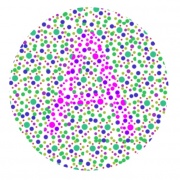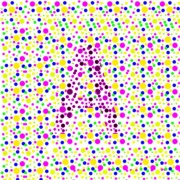Contents |
Colour Vision Deficiencies: Are People Really “Colour Blind?”
Introduction
We live in a colourful world and enjoy the ability to appreciate an endless variety of hues, tints and tones; our world is enhanced by artworks, sunsets and blooming flowers. The ability to differentiate different colours is important to us, just as a good sense of smell is necessary to really enjoy a gourmet meal: without smell the meal is nice, but not wonderful.
The term “colour blindness” is probably not appropriate when describing most people whose colour perceptions are unusual or abnormal. Colour vision deficiencies vary from a slight difficulty in distinguishing between shades of the same colour, which is fairly common, all the way to being unable to appreciate any colour at all, which is very rare.
Colour Vision Deficiencies (CVD) are either inherited or acquired. Most cases are inherited, but colour disturbances are sometimes caused by retinal or optic nerve pathologies such as multiple sclerosis or diabetes. Inherited CVDs affect both eyes, while acquired types can affect only one eye, depending on the underlying cause.
In the normal eye there are neuron cells in the retina called rods and cones. Rods are important in low-light conditions, sensing light, motion and detecting brightness and contrast. Cones allow us to detect and differentiate colours and small details like a sewing needle or reading material. Rods are more prevalent in the peripheral retina while cones are more concentrated in and around the macula, although both types of neurons are seen to some extent all through the retina.
Because cone cells are also responsible for clear detailed vision, a moderate to severe CVD is usually accompanied by decreased clearness of vision which is not improved with corrective lenses. It doesn’t matter what lenses are used when the lack of detail-oriented cones causes not only the CVD but also makes best-corrected vision less sharp and clear.
Cones come in three different types, one for sensing red light, another for blue and a third for green. People with CVD have either fewer cones for each colour, or fewer cones of one type. It is also possible that one type of colour-sensing cone is present but does not function properly.
Inherited Colour Vision Deficiencies
Roughly, ten percent of the male population has some degree of abnormal colour vision. The condition is hereditary and gender-linked, meaning that fathers pass the gene on to their daughters but not to their sons. Mothers, however, are almost always unaffected but do pass the gene to all of their children. Men are at least 20 times more likely than women to have genetic CVD.
In men having some degree of CVD, one of the three types of cones is either not functional or missing. There are two main types of genetic CVDs, although there is some overlap between them; difficulty differentiating particular shades of red and green, or difficulty with blues and yellows. The blue-yellow type of CVD is seen less often than the red-green type.
Normally, the cones register different colours and send that information through the optic nerve back into the brain, but if one or more types of cones are lacking, it will be difficult or impossible to see that primary colour. (Note: the term “primary colours” being used here is not the same as the ones on an artist’s colour wheel, which are blue, red and yellow.)
The most common type of genetic CVD is red-green deficiency, but that doesn’t mean that people having this type of CVD can’t see these colours at all, but just that they might have difficulty perceiving the differences between shades of them; in many cases, the ability to see them or not depend on how bright or dark they are. A green field, for example may appear to be brown or dark red.
Another, rarer type of CVD is blue-yellow. This type of CVD is not only rarer but is more severe, because people with this type also usually have some degree of red-green deficiency, too.
It is perfectly possible for a person to have a colour vision abnormality and not know it. For example, a person with a red-green deficiency learns to see the “right” colour; trees are known to have green leaves, so he will call the colour he sees “green.” It is also possible for a parent not to suspect there may be a colour vision problem until it causes confusion or a misunderstanding.
One reason for a comprehensive vision examination before the age of three is that many teaching materials rely heavily on colour perception or colour coding, and can adversely effect learning. Early diagnosis of CVD can spare a child from the frustration he may feel as the result of not being able to appreciate the differences in colour that his classmates find easy.
While most people with a CVD find their vision is not an issue in their daily lives, certain professions do rely more heavily on accurate colour sensitivity. Examples include electricians, commercial artists, designers of all types and certain manufacturing and marketing occupations.
Inherited CVD is present at birth and will not progress or change from a mild form to a more severe one. It is possible, however, that a person with CVD can have an added acquired CVD, just like anyone else.
However, fears of being handicapped by colour vision problems are not warranted, because it is present from birth and people learn to make adaptations, usually without even realizing their colour vision is different from that of others.
Acquired Colour Vision Deficiencies
There are many causes for acquired colour vision deficiency; among them are:
- Diabetes
- Glaucoma
- Parkinson’s disease
- Alzheimer’s disease
- Macular degeneration
- Multiple sclerosis
- Chronic alcoholism
- Leukemia
- Sickle cell anemia
In addition, some medications can cause problems with colour vision, such as those used to treat heart problems, high blood pressure, infections and psychological problems. The medication used worldwide in the treatment of malaria is widely known to be toxic and cause colour disturbances.
Some chemicals are toxic, too, like fertilizers, styrene or benzene.
Testing and Diagnosis
Pseudoisochromatic (Soo-doh-eye-so-kroh-matic) plates, also known as the Ishihara test after its inventor, consist of a set of 38 cards, each of which is covered with coloured dots. Some of the dots form a pattern (usually a number) within the card that is visible to people with normal colour vision, but which is not visible to those with CVD. Some of the coloured plates have a different number, visible only to those people who have a specific type of CVD, like red-green or blue-yellow, so information can be gathered about what type of defect it is.
| Above: Two versions of Ishihara-type plates that might be used for differentiating between two types of Inherited colour vision deficiencies. | |
The Farnsworth-Munsell 100 Hue Test is very detailed and requires more time to perform, so it is usually used by researchers investigating different types of deficiencies. A test subject is presented with small tabs of coloured paper (usually in the form of small discs set into bottle caps) and asked to put them in order, starting from one tab until they are arranged in a continuum of gradually changing colour as perceived by the subject. When the tabs are inverted each one has a number which allows the scorer to connect dots associated with each disc which will reveal the severity and the type of CVD present. (For those interested in this area, doing the Farnsworth 100 can be a fascinating experience.)
Colour vision tests should always be done in an area where the lighting has been set up to mimic natural outdoor light as closely as possible. It is important that testing materials for colour vision deficiencies be protected from heat, light and foreign substances such as the oils found in skin, so plates and tabs should be stored in a cool, dark place and when being used, people being tested should be asked not to touch them. Small children, however, may be given a medium-weight soft brush suitable for watercolour paints that they can use to trace the lines they see, so the ability to identify numbers doesn’t matter as much.
Both testing methods discussed above are available in abbreviated form, which can be used as a tool for quick screening; pseudoisochromatic plates are available in sets of 14 or 24 and the Farnsworth-Munsell is available in a set of 15 discs.
Acquired CVDs can be sorted out from those that are inherited fairly easily, because while there will be an abnormal response to testing, it will not usually conform to expected, known anomalies, but will show more random results. Acquired CVDs are also much more likely to be present in only one eye, or will show up differently from one eye to the other.
Online colour vision tests are usually variations of Ishihara plates, but it is hard to control colour qualities; computer monitors also have various graphics and colour capabilities. The best that online tests can do is screen for the presence of possible CVDs. CVD testing should always be done under controlled light conditions and be administered by trained professionals using standardized testing materials.
Treatment
There is no treatment or cure for inherited CVD, but if it is caused by illness or injury, treating these may improve colour vision.
Most CVDs are mild and cause little or no difficulty, but in their more severe forms they can significantly impact daily life. For example, a person cooking meat may be unable to tell if the piece of meat is raw or overcooked, and being unable to distinguish ketchup from chocolate syrup has obvious drawbacks.
Presently, technology may hold a key to treatment of CVDs; electronic devices can already identify colours by using sensors that identify the wavelength of light reflected from the object in question.
Meanwhile, life can be made easier for those with a CVD by using various strategies like labeling and sorting clothing or accessories for a child to help coordinate his own wardrobe helps him to be more independent. Street signs can be learned by shapes and traffic signals can be identified by their brightness and position, because stoplights have red positioned at the top. Give information to the child’s teachers that there may be difficulty with coloured print on coloured backgrounds and that colour coding might not mean anything to a child with a CVD. The child should be encouraged to find his own methods for adapting, which might be even more effective in the long term.
Summing Up
Colour vision deficiencies do not represent the end of the world, or even make things particularly hard in most cases. Coping strategies as have already been noted can be helpful to those with more severe inherited CVDs.
Careful monitoring of all medications and regular checkups including colour vision testing should be done for patients with any of the listed chronic conditions or who are using a prescription for any suspected toxicities; it is much easier to prevent a problem than regain abilities that have been lost.
In surveys, vision always comes in as the most important of our five senses. We should stop, not only to smell the roses, but to appreciate their beautiful colours. This is not meant to be cruel or demeaning to those with CVDs but as a reminder that life is still full, but full of surprises.



